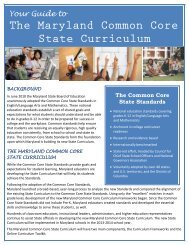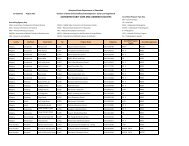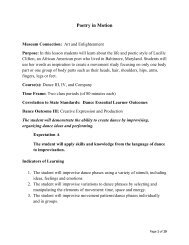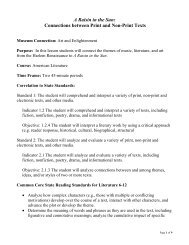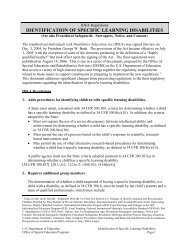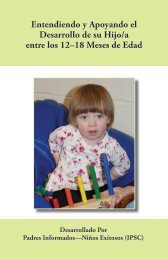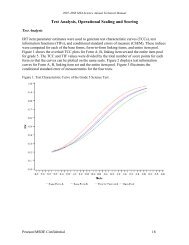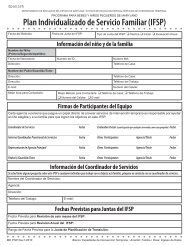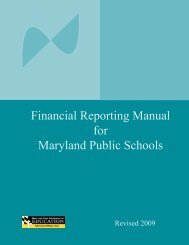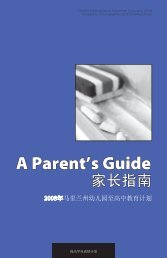Do Not Resuscitate - Maryland State Department of Education
Do Not Resuscitate - Maryland State Department of Education
Do Not Resuscitate - Maryland State Department of Education
You also want an ePaper? Increase the reach of your titles
YUMPU automatically turns print PDFs into web optimized ePapers that Google loves.
MODEL POLICY – MANAGEMENTOF DO NOT RESUSCITATE ORDERSIN MARYLAND SCHOOLSMARYLAND STATE SCHOOL HEALTH SERVICESGUIDELINEJANUARY 2006<strong>Maryland</strong> <strong>State</strong> <strong>Department</strong> <strong>of</strong> <strong>Education</strong> <strong>Maryland</strong> <strong>Department</strong> <strong>of</strong> Health andStudent Services and Alternative Programs Mental Hygiene Center for MaternalBranch& Child Health200 West Baltimore Street 201 West Preston StreetBaltimore, <strong>Maryland</strong> 21201 Baltimore, <strong>Maryland</strong> 21201Phone: 410-767-0311 Phone: 1-877-463-3464TTY/TDD: 410-333-6442 TTY/TTD: 1-800-735-2258
MARYLAND SCHOOL HEALTH SERVICES GUIDELINEMODEL POLICY - MANAGEMENT OF DO NOT RESUSCITATE ORDERSIN MARYLAND SCHOOLSOverviewThe <strong>Maryland</strong> School Health Services Standards (COMAR 13A.05.05.09) require that each schooldevelop a guide for emergency care, including the provision <strong>of</strong> cardiopulmonary resuscitation andfirst aid. Additionally, the standards require that each local board <strong>of</strong> education, in conjunction withthe local health department, formulate policies to ensure the provision <strong>of</strong> health services to studentswith special health needs (COMAR 13A.05.05.08).In May 1994, the Attorney General issued an Opinion, which determined that public schoolsgenerally should accept and follow the physician’s instructions contained in a <strong>Do</strong> <strong>Not</strong> <strong>Resuscitate</strong>(DNR) order from the parents <strong>of</strong> a terminally ill child who is enrolled in school (Opinions <strong>of</strong> theAttorney General, 1994). DNR is defined as the withholding <strong>of</strong> cardiopulmonary resuscitation(CPR), artificial ventilation, and other related life-sustaining procedures in the event <strong>of</strong> cardiac orrespiratory arrest. A DNR order is separate from other aspects <strong>of</strong> the student’s care. Unlessotherwise specified, there should be no implied or actual abandonment <strong>of</strong> other supportive care suchas administration <strong>of</strong> oxygen, suctioning, use <strong>of</strong> the Heimlich maneuver, control <strong>of</strong> bleeding andpain, and positioning for comfort.The <strong>Do</strong> <strong>Not</strong> <strong>Resuscitate</strong> OrderAn original or copy <strong>of</strong> a written physician’s order and parental/guardian/surrogate authorizationmust be submitted on the <strong>Maryland</strong> Emergency Medical Services (EMS) Medical Care/<strong>Do</strong> <strong>Not</strong><strong>Resuscitate</strong> (DNR) Order form. The designated school health pr<strong>of</strong>essional should review the orderand refer questions or concerns to the local supervisor <strong>of</strong> school health services. A written statementsigned by both the physician and parent/guardian affirming the continuance <strong>of</strong> the order and all itsconditions is recommended at least annually at the beginning <strong>of</strong> the school year.When the student becomes 18 years <strong>of</strong> age, the authorization must come from the student rather thanthe parent/guardian. If the student, now considered an adult, lacks the capacity to make informeddecisions about his or her health care, a certificate <strong>of</strong> incapacity signed by two physicians must beobtained in accordance with Health General Article, Section 5-606(a) <strong>of</strong> the Annotated Code <strong>of</strong><strong>Maryland</strong> and a new EMS Medical Care/DNR Order must be signed by a physician and theparent/guardian.Emergency medical services (EMS)-911 and commercial ambulance services will only honora DNR request if an original or copy <strong>of</strong> the order is provided on the appropriate state form,the EMS Medical Care/DNR Order, or if the student is wearing the standard <strong>State</strong>-issuedDNR bracelet. Forms are not numbered and patients or caregivers may make as many copies<strong>of</strong> the form as they need and keep those copies available. Forms are available atwww.miemss.org/DNRorder_form.pdf . Individuals or institutions may download as manyforms as they need. Anyone who does not have access to the Internet may contact theModel Policy - Management <strong>of</strong> <strong>Do</strong> <strong>Not</strong> <strong>Resuscitate</strong> Orders in <strong>Maryland</strong> Schools 20061
MARYLAND SCHOOL HEALTH SERVICES GUIDELINEAn individualized nursing care plan must be developed by the designated school healthpr<strong>of</strong>essional, and a medical emergency protocol should be completed by the student’sphysician. These plans/protocols should address the following items, as appropriate:• Permissible medical care <strong>of</strong> the student;• Medical interventions that can and cannot be done for the student;• Contact information in the case <strong>of</strong> an emergency situation;• Steps to be taken in the case <strong>of</strong> impending or actual death in all school-relatedenvironments;• Hospice protocol, if indicated;• Plans for training and supporting the staff and the student’s peers;• Means by which EMS will be provided notice <strong>of</strong> a DNR order in case <strong>of</strong>an emergency;• Communication and collaboration with the family;• Plans for securing a death certificate; and• Emotional support for the student and family.NOTE: EMS PERSONNEL MUST FOLLOW A SPECIFIC, PRE-DETERMINED, STATEWIDEEMS MEDICAL CARE/DNR PROTOCOL UPON PRESENTATION OF A VALID EMSMEDICAL CARE/DNR ORDER FORM OR BRACELET WITH INSERT.School transportation protocol• With parent/guardian permission, the school administrator or designee willmeet with the student’s bus driver, attendant (if applicable), transportation supervisorand/or local school system central <strong>of</strong>fice administrator to develop a plan forimplementing the order.• Provisions for communication must be established. The school systemmay choose to equip the bus with a cellular phone for use in emergency situations.• The bus driver should be notified <strong>of</strong> the existence <strong>of</strong> the order byproviding the driver with a copy <strong>of</strong> the order or placing a sticker on the student’semergency card.• The parents/guardians are responsible to ensure that a copy <strong>of</strong> the order orbracelet is with the student at all times, including while the student is on a school bus.School personnel will take reasonable efforts to obtain an order/bracelet.• A master list <strong>of</strong> students with DNR orders should be maintained by thelocal school system Transportation Office.• Confidentiality must be maintained by all transportation personnel.The designated school health pr<strong>of</strong>essional is responsible for ensuring that all staff members,including transportation personnel, who are informed <strong>of</strong> the DNR order, are trained to followthe planned procedures.It is recommended that the families <strong>of</strong> students with DNR orders be encouraged to enrollin a local hospice program through the Hospice Network <strong>of</strong> <strong>Maryland</strong> (HNM). Hospicecare neither hastens nor prolongs death; it allows the dying process to occur naturallywhile supporting the patient to the highest degree possible. Hospice attempts to help thechild live each day to the fullest in comfort and peace.Model Policy - Management <strong>of</strong> <strong>Do</strong> <strong>Not</strong> <strong>Resuscitate</strong> Orders in <strong>Maryland</strong> Schools 20063
MARYLAND SCHOOL HEALTH SERVICES GUIDELINEA child may be admitted to a hospice program after meeting the following general criteria:• Must have a physician-diagnosed terminal condition.• Must have a limited life expectancy, usually but not always, <strong>of</strong> twelvemonths or less.• Must have a physician who will continue to be involved in his/her care.• Both the child’s family and physician have agreed upon the decision tobegin supportive care and end curative treatment.• The family and student (as appropriate) must want and agree to hospicecare.Activating the OrderEvery effort should be made to transport the student from school at the first signs <strong>of</strong> a deterioratingcondition. The parent/guardian should be contacted and the established emergency protocol shouldbe followed.If the student suffers distress unrelieved by physician-authorized medical care:• Call 911 to activate the EMS and follow the orders/plan as previouslyestablished with the physician and parent/guardian;• Have a copy <strong>of</strong> the EMS Medical Care/DNR Order form or bracelet available for EMSpersonnel upon their arrival. In most cases, EMS transport is the best choice; and• <strong>Not</strong>ify hospice if applicable.If the student dies before being transported from school:• Seclude the student in the health room (or other appropriate location),while maintaining as normal an atmosphere as possible in the rest <strong>of</strong> the building;• Activate the EMS, who will transport the student to the nearest hospitalemergency department. <strong>Not</strong>ify EMS that the student is a DNR and request that theysilence their sirens upon approach if consistent with local policy;• Contact the parent/guardian, physician, and other designated persons.• If the plan indicates that the parents do not want EMS transportation, theschool can have EMS transport the student, if the parent-specified alternative does notmaterialize in a reasonable amount <strong>of</strong> time;• If EMS is not available or the plan indicates that the parents do not wishEMS transport, initiate steps to obtain a physician’s death certificate and transport thestudent to the location in accordance with the parents’ instructions; andIf the student suffers distress or dies while being transported on the school bus:• The bus should be stopped and existing transportation emergencytechnical bulletin should be applied (i.e., driver/attendant are both responsible forrecognizing an emergency, calling 911, and notifying locally designated schoolauthorities.Model Policy - Management <strong>of</strong> <strong>Do</strong> <strong>Not</strong> <strong>Resuscitate</strong> Orders in <strong>Maryland</strong> Schools 20064



